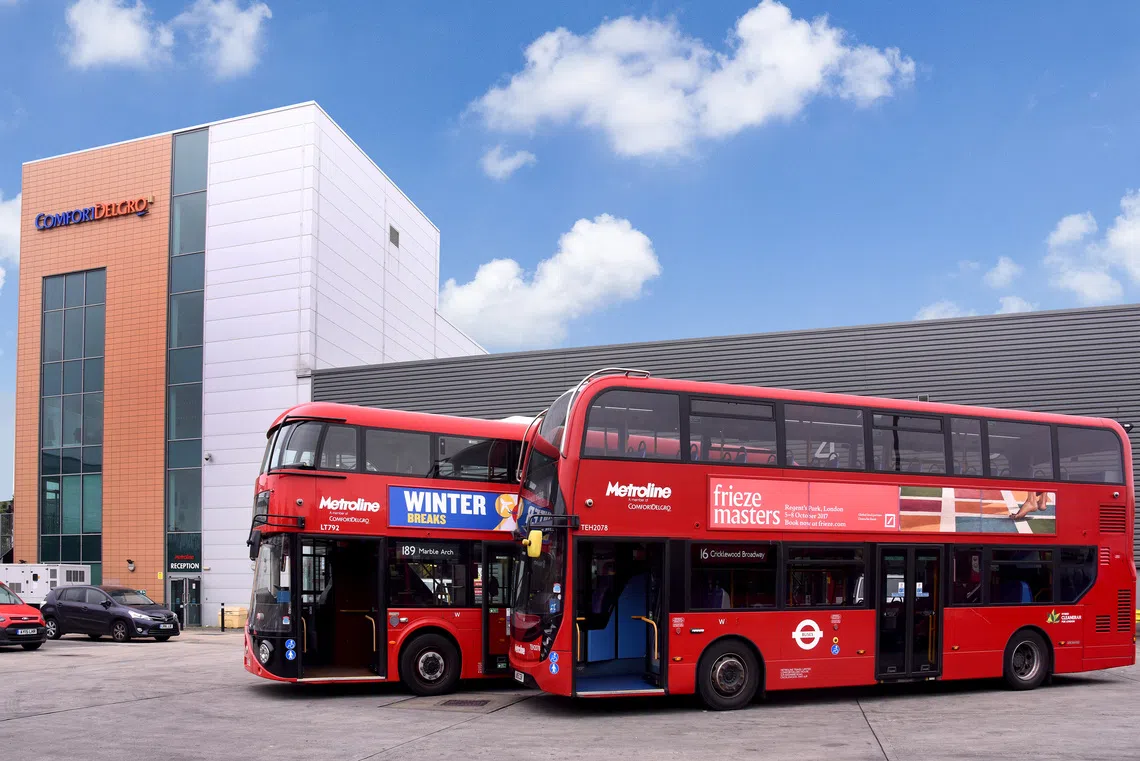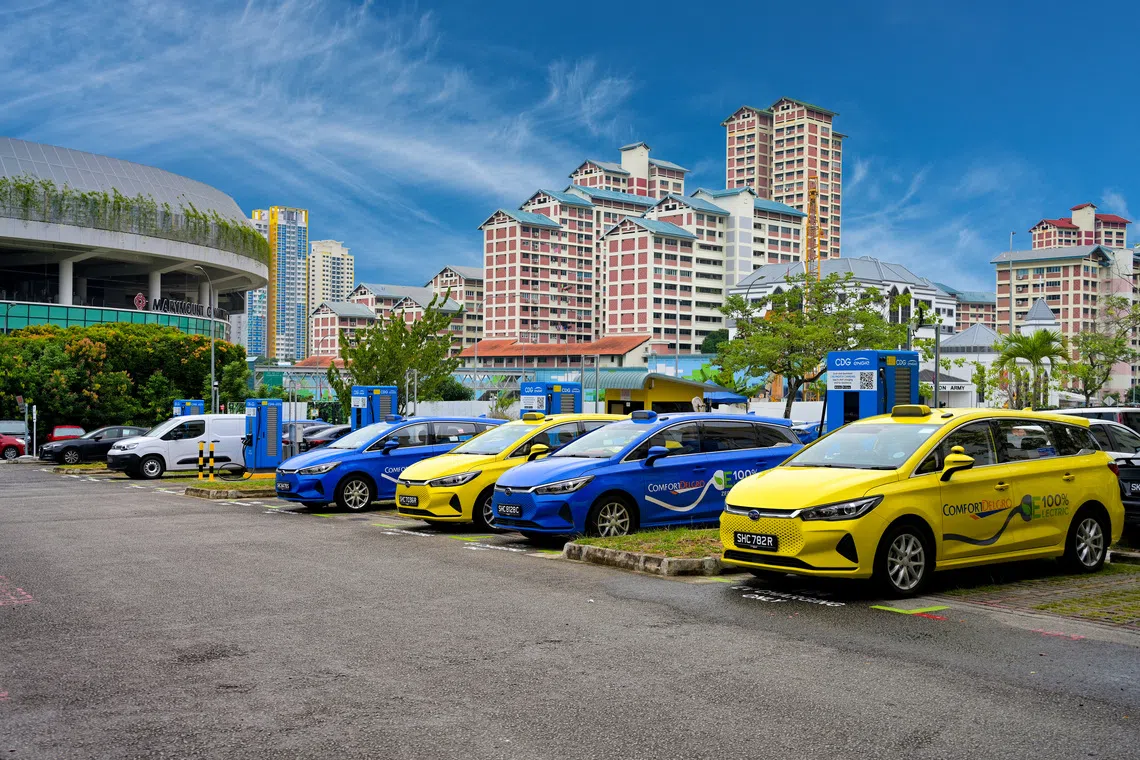Being sustainable and Singaporean are equally important for ComfortDelGro
Group chairman Mark Greaves says the company wants to bring Singapore-style clean and efficient transport to other markets as it continues to expand abroad

[SINGAPORE] Being sustainable is just as much a part of ComfortDelGro (CDG) as its Singaporean roots – and both of these things are helping to fuel the transport giant’s growing presence abroad.
CDG chairman Mark Greaves said that the company has two messages for those it serves abroad: “Firstly, Singapore public transport is world-class, and we are bringing it to you. Secondly, Singapore public transport is very focused on sustainability, and we can help you to benefit from that.”
Transport companies often have a major challenge in sustainability since their Scope 1 emissions – or direct emissions from operations – involve burning fuel to power vehicles.
But mainboard-listed CDG is well on its way to a greener future, having won the Impact Enterprise Excellence Award in the large enterprise category at the 2025 Sustainability Impact Awards, jointly presented by The Business Times and UOB.
In 2018, it established a group sustainability office – which works with more than 50 representatives from other business units – that tracks more than 100 environmental, social and governance metrics globally.
In 2022, CDG was the first land transport operator in South-east Asia to have its carbon emissions targets approved by the UN-backed Science Based Targets Initiative, a gold standard for corporate decarbonisation goals.
Using 2019 as a baseline, by 2032 the company targets a 54.6 per cent reduction in absolute Scope 1 and 2 greenhouse gas (GHG) emissions, and 61.2 per cent reduction in Scope 3 emissions from fuel and energy-related activities.
Scope 2 emissions are from purchased and used energy, while Scope 3 emissions arise from a company’s value chain.
The group also uses the United Nations’ Sustainability Development Goals as guidelines for its emissions reduction in energy use, air quality and climate change adaptation targets, among others, along with clear targets in social, governance and economic aspects.
The long run

Rather than seeing sustainability as an extra cost, Greaves describes it as part of the company’s DNA and a “huge opportunity to do good”.
“It’s a key part of our proposition to the communities that we serve; and to all our stakeholders that we will bring them safe, reliable, sustainable transport options,” he said. “Their buy-in to that validates our societal licence to operate.”
While Singapore is still the biggest market for CDG, in the past few years the company has been aggressively expanding its global footprint and now has operations in the UK and EU, Australia, China and Malaysia.
In 2024, its operating profit increased almost 19 per cent to S$322.9 million; 34.9 per cent of the operating profit was from abroad, compared to 26 per cent in 2023.
Even with this expansion, CDG has made significant progress in managing its emissions.
In 2024, its combined Scope 1, 2 and 3 emissions decreased 3.5 per cent to around 1.8 million tonnes of carbon dioxide equivalent (tCO2e) from 2019 levels. Notably, it managed to slash Scope 1 emissions by 20.7 per cent, although its Scope 2 and 3 emissions increased by 16.5 per cent and 18 per cent, respectively.
Scope 1 reductions were achieved largely due to a shift away from more polluting vehicle types.
At the same time, increased adoption of electric vehicles was a reason for the increase in Scope 2 emissions, while Scope 3 emissions increased due to better reporting, including data collection and calculation methods.
Clean machine

Despite that, the group’s carbon intensity has decreased, meaning it has managed its emissions while growing revenue and profits.
The group’s GHG emissions intensity has decreased to 239 tCO2e per S$1 million revenue, from 276 tCO2e per S$1 million revenue in 2022.
This comes as the group’s earnings for FY2024 rose 12.9 per cent year on year, to S$115.2 million, and revenue grew 16.9 per cent over the same period to S$2.4 billion.
Scope 1 emissions are difficult to reduce for a transport company, since they include emissions from vehicle fleets. CDG has not only set specific, ambitious goals to reduce that source of pollution in the long term; it is also well on its way to achieving them.
CDG has around 43,000 vehicles in its global taxi and private-hire car fleet, with 70 per cent of those being cleaner-energy vehicles, while 18 per cent of its 8,000-strong bus fleet are cleaner models.
By 2030, it aims to use cleaner vehicles, including hybrids, hydrogen or electric vehicles, for 50 per cent of its bus operations and 90 per cent of its car fleet. The longer-term target is 100 per cent by 2040 for cars and 2050 for buses.
This approach is already working; the switch accounts for CDG’s reduced Scope 1 emissions since 2019. But it is also actively working to reduce its Scope 2 scores.
While most of the group’s global rail operations are powered by electricity, Greaves is well aware that electricity usage itself results in Scope 2 emissions.
“You don’t necessarily always know precisely where your energy is coming from… It does raise issues for Scope 2 because we have to try to track (the emissions) down and find out where it’s coming from.”
In the meantime, CDG has focused on making sure the rail systems run as efficiently as possible, including by using artificial intelligence for operations, and also increasing its own renewable energy supply where possible, such as with solar panels.
Sustainable and Singaporean
Greaves said the company’s reputation for putting sustainability front and centre is as equally important as its Singaporean origins. In fact, it is those origins that have helped it find further success.
CDG began as NTUC Comfort, the taxi cooperative launched by the National Trades Union Congress in 1970. Greaves said this has kept collaboration a key tenet of the organisation.
“We’re very committed to Singapore, and it mustn’t be forgotten that this is at the heart of our collaborative approach to everything we do that brings in all our stakeholders.
Providing transport for communities is not just about making a bus service available or using cleaner energy, Greaves adds, saying that engaging with the community and finding out what they want is a key to success.
“We talk to community leaders. We’ll find out what they want, what they need… The community is key to what we’re doing, because we must deliver to them a service that they want.”
While not every market that CDG operates in may have fully electric vehicles or use the cleanest power, Greaves argues that being there and being on the job gives CDG the chance to apply its approach for long-term wins for all involved.
For instance, in the case of a conventional, less sustainable bus route abroad, where electric buses are not possible, CDG works with the stakeholders to research what alternatives are possible, such as hybrid buses, improved route efficiency, and even more sustainable maintenance and service efforts.
“We can make it better. As I say, if we’re on the inside, we can make it better,” he quipped.
Decoding Asia newsletter: your guide to navigating Asia in a new global order. Sign up here to get Decoding Asia newsletter. Delivered to your inbox. Free.
Copyright SPH Media. All rights reserved.

